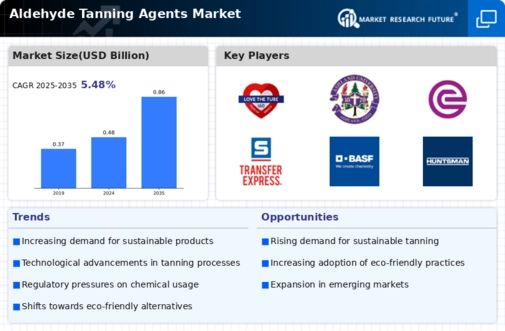Market Growth Projections
The Global Aldehyde Tanning Agents Market Industry is projected to experience substantial growth in the coming years. With an estimated market value of 0.48 USD Billion in 2024, the industry is expected to expand to 0.86 USD Billion by 2035. This growth trajectory indicates a compound annual growth rate of 5.5% from 2025 to 2035, reflecting the increasing demand for aldehyde tanning agents across various sectors. Factors contributing to this growth include rising leather consumption, technological advancements, and a shift towards sustainable practices. These projections highlight the potential for investment and development within the industry.
Market Diversification and Product Innovation
Market diversification and product innovation are vital drivers of the Global Aldehyde Tanning Agents Market Industry. As consumer preferences evolve, manufacturers are compelled to innovate and diversify their product offerings. This includes the development of specialized aldehyde tanning agents tailored for specific applications, such as automotive leather or high-fashion goods. Such innovations not only cater to niche markets but also enhance the overall appeal of leather products. The ongoing trend of customization in the leather industry suggests that product innovation will remain a key focus, potentially influencing market dynamics and contributing to sustained growth in the coming years.
Rising Leather Consumption in Emerging Markets
The Global Aldehyde Tanning Agents Market Industry is experiencing growth due to rising leather consumption in emerging markets. Countries in Asia-Pacific and Latin America are witnessing a surge in demand for leather products, driven by urbanization and increasing disposable incomes. This trend is particularly evident in the automotive and fashion sectors, where leather is a preferred material. As these markets expand, the demand for aldehyde tanning agents is likely to increase, supporting the overall market growth. The anticipated compound annual growth rate of 5.5% from 2025 to 2035 further underscores the potential of these emerging markets in shaping the industry's future.
Technological Advancements in Tanning Processes
Technological advancements are significantly influencing the Global Aldehyde Tanning Agents Market Industry. Innovations in tanning processes, such as the development of more efficient aldehyde formulations, are enhancing the quality and durability of leather products. These advancements not only improve production efficiency but also reduce waste and energy consumption. For example, the introduction of advanced machinery and automation in tanning facilities has streamlined operations, leading to cost savings. As the industry evolves, these technologies are expected to contribute to a projected market growth to 0.86 USD Billion by 2035, indicating a robust future driven by innovation.
Growing Demand for Eco-Friendly Tanning Solutions
The Global Aldehyde Tanning Agents Market Industry is witnessing an increasing demand for eco-friendly tanning solutions. As consumers become more environmentally conscious, manufacturers are compelled to adopt sustainable practices. Aldehyde tanning agents, particularly those derived from renewable resources, are gaining traction. This shift not only aligns with consumer preferences but also complies with stringent regulations aimed at reducing environmental impact. For instance, the market is projected to reach 0.48 USD Billion in 2024, reflecting a growing inclination towards sustainable products. This trend suggests that eco-friendly alternatives may play a pivotal role in shaping the future of the industry.
Stringent Regulatory Frameworks Promoting Safe Practices
Stringent regulatory frameworks are playing a crucial role in the Global Aldehyde Tanning Agents Market Industry. Governments worldwide are implementing regulations to ensure the safety and environmental compliance of tanning agents. These regulations often promote the use of safer alternatives, such as aldehyde-based agents, which are perceived as less harmful compared to traditional tanning methods. Compliance with these regulations not only enhances product safety but also boosts consumer confidence. As a result, manufacturers are increasingly investing in research and development to create compliant products, thereby driving market growth and ensuring a sustainable future for the industry.
























